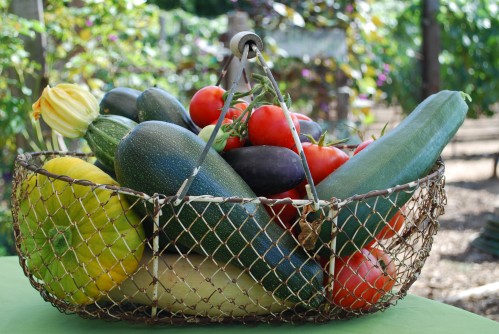 Imagine, it is August, and summer vegetables are at their peak. You are reaping all the benefits of your time invested, and steps taken to ensure a bountiful vegetable harvest. It gives me so much satisfaction to harvest these beautiful and flavorful vegetables.
Imagine, it is August, and summer vegetables are at their peak. You are reaping all the benefits of your time invested, and steps taken to ensure a bountiful vegetable harvest. It gives me so much satisfaction to harvest these beautiful and flavorful vegetables.
If you have never had a vegetable garden before, or would like to review what it takes to have a successful vegetable garden, please follow these simple basic steps.
1) Make your plan first on paper, what you are going to plant, where your vegetables will be planted in your garden plot, and when to expect harvest for each. Read and follow seed packet directions or seedling instructions, for planting, spacing, and thinning.
2) Plant the vegetables that you and your loved ones like to eat the most. If you're not interested in a certain type of vegetable, than don't grow it. I always plant an assortment of heirloom tomatoes and squash each year. For fun, I always try and plant one or two new vegetables that I have never grown before. Don't be afraid to experiment with some of the exciting heirloom vegetable seeds available.
3) Pick a nice sunny, level, location away from trees and shrubs that might shade, and compete for water and nutrients. Make sure this location has a convenient water source. Starting out, don't make your garden too big. A 10' x 10" plot will feed a family easily, with lots of vegetables to share. Plant your tallest vegetables to the north, so they don't shade the shorter ones, and continue on down your plot with your shortest plants on your south side. Generally, it is wise to surround your vegetable plot with a fence to keep out critters like Peter Rabbit.
4) Work your soil first before planting. Ideally, you want loose, rich, well-drained soil for a vegetable garden. If you have finished compost, or the ability to add nutrient-rich amendments, add to your soil, turn over well, and mix in. Level your ready-soil before planting.
5) Mark off your vegetable plot in "one foot segments" using two stakes tied with string the width of your desired vegetable plot, to provide a straight line for planting. Some of your seeds might require rounded mounds, allow room for them. Adhere to the types of vegetables that are planted in the spring, summer, fall, and even winter.
6) Regular weeding and hoeing is a must. This keeps your soil loose for water penetration and air. Weeds if left unchecked, can rob nutrients from your growing vegetables. Water requirements vary according to your particular soil type and zone. Plants generally need 2" of water per week. Some plants have specific deep watering requirements, like tomatoes. If possible, water your vegetable garden in the morning.
7) Know when and how to harvest your vegetables for optimum flavor and harvest. This will help your vegetables retain their maximum vitamin content and flavor. Mark it on your calendar beforehand, the approximate time frame your specific vegetables should be harvested, and observe your vegetables closely approaching this time.
Add your thoughts, do you have other tips you have used for successful vegetable gardening. Do you plan on continuing your vegetable gardening into the fall, and throughout the year. Do you have a favorite heirloom vegetable you planted this year to share.
